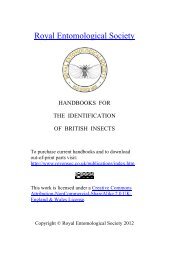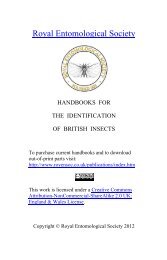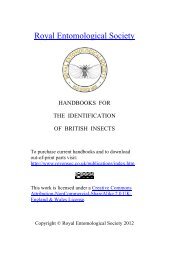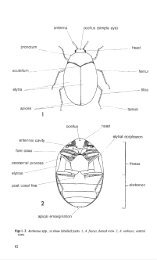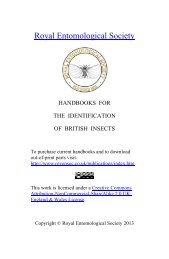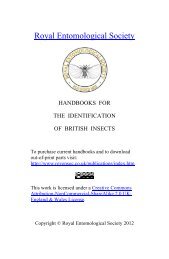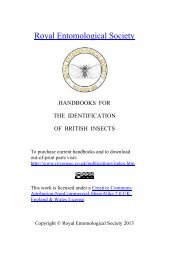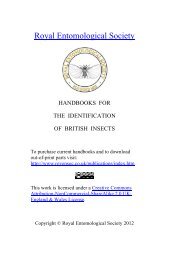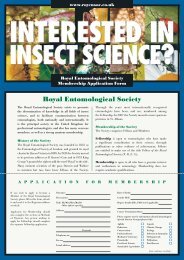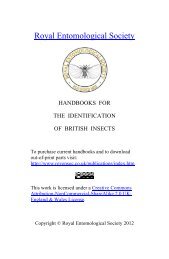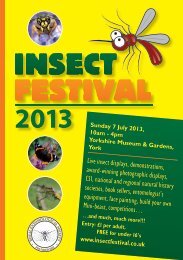Vol 10 Part 14. An introduction to the immature stages of British Flies ...
Vol 10 Part 14. An introduction to the immature stages of British Flies ...
Vol 10 Part 14. An introduction to the immature stages of British Flies ...
Create successful ePaper yourself
Turn your PDF publications into a flip-book with our unique Google optimized e-Paper software.
herbaceous garden plants. The main pest species is Tipula paludosa Meigen which<br />
occurs in all soil types (clay, marl, peat, sand). The worst attacks occur in <strong>the</strong> spring,<br />
especially on young plants <strong>of</strong> crops sown on freshly ploughed grassland when <strong>the</strong><br />
lea<strong>the</strong>r jacket population may be as high as hundreds <strong>of</strong> thousands per acre. Usually<br />
Jea<strong>the</strong>rjackets feed on roots and underground stems just below <strong>the</strong> soil surface but on<br />
warm nights <strong>the</strong>y will feed on <strong>the</strong> surface, cutting <strong>of</strong>f <strong>the</strong> plants at soil level. Sometimes,<br />
especially after heavy rain, <strong>the</strong>y will be forced up through cracks in concrete, between<br />
paving s<strong>to</strong>nes etc and become trapped on <strong>the</strong> surface in very large numbers on hard<br />
areas in<strong>to</strong> which <strong>the</strong>y cannot burrow, such as paths and concrete surrounds <strong>of</strong> houses,<br />
and thus be reported as a nuisance.<br />
Brindle (I 967) keys <strong>the</strong> genera and species <strong>of</strong> this subfamily. The common 'pest'<br />
species usually found in pasture soil or gardens may be identified as follows.<br />
Dorsum <strong>of</strong> prothorax with two raised welts (fig. 16). (N. appendiculata (Pierre) ( = maculata<br />
Meigen) is a common garden species) . . . . . Nephro<strong>to</strong>ma spp.<br />
Dorsum <strong>of</strong>prothorax without raised welts (fig. 15). . . . . (Tipula sp.) 2<br />
2 Dorsal pairs (dl) <strong>of</strong> anal lobes sclerotized <strong>to</strong> tip (fig. 13) . . . T. vernalis Meigen<br />
Dorsal lobes not sclerotized . . . . . . . . . . . . . . . . . 3<br />
3 Only <strong>the</strong> lateral pair (lp) <strong>of</strong> anal papillae elongated, <strong>the</strong> ventral (vp) being rounded (fig. <strong>10</strong>)<br />
. . . . . . . . . . . . . . . . . . . . . T. paludosa Meigen<br />
At least two pairs <strong>of</strong> elongated, tapering, anal papillae, lateral (lp) and ventral (vp) . 4<br />
4 Pigmented marks between spiracles obvious (fig. 12), pigmented borders <strong>of</strong> anal lobes<br />
darker, disc whitish yellow, larva yellowish brown in colour, not translucent . . . .<br />
. . . . . . . . . . . . . . . . . . . . T. czizeki De Jong<br />
Pigmented marks between spiracles weak, <strong>of</strong>ten absent (fig. 11), pigmented borders <strong>of</strong> anal<br />
lobes lighter, disc whitish, larva greyish, ra<strong>the</strong>r translucent . . . . T. oleracea L.<br />
Cylindro<strong>to</strong>minae. The four <strong>British</strong> species <strong>of</strong> this subfamily have very distinctive<br />
caterpillar-like larvae which feed openly on <strong>the</strong> leaves <strong>of</strong> marsh plants.<br />
Diogma glabra/a (Meigen) (fig. 17) is green in colour and occurs in terrestrial mosses,<br />
usually on s<strong>to</strong>nes in limes<strong>to</strong>ne woodlands; Triogma trisulcata (Schummel) is dark<br />
brown or brownish green and occurs in semi-aquatic mosses (e.g. Hypnum cuspidatum)<br />
on moors; Phalacrocera replicata (L.) (fig. 19) is dark brown, paler below and is found<br />
on aquatic mosses (e.g. Hypnumfluitans or Sphagnum) in acid pools on moors or in<br />
woodlands; Cylindro<strong>to</strong>ma distinctissima Meigen is light green, darker dorsally and<br />
feeds on <strong>the</strong> leaves <strong>of</strong> Caltha, Viola, Stellaria, <strong>An</strong>emone, etc.<br />
Brindle ( 1967) keys <strong>the</strong> <strong>British</strong> genera and species.<br />
Limoniinae. The larvae <strong>of</strong> this subfamily can be approximately separated in<strong>to</strong> four<br />
tribes as below.<br />
Brindle ( 1967) keys <strong>the</strong> <strong>British</strong> genera and species so far described as larvae and Crisp<br />
& Lloyd (1954) give much useful biological information.<br />
Limoniini - larvae without obvious anal lobes, frequently living in silken tubes,<br />
herbivorous. Larvae occur in wet earth, decaying vegetation immersed in water or<br />
mud, on partly submerged s<strong>to</strong>nes in shallow streams, on piles and bridge piers where<br />
<strong>the</strong>y feed on algae. Larvae <strong>of</strong> Limonia (Geranomyia) unicolor Haliday feed on algae on<br />
marine structures washed by <strong>the</strong> tide. L. nubeculosa Meigen (fig. 29) is a very common<br />
species beneath leaves in woods. There are 58 <strong>British</strong> species in 7 genera in this tribe <strong>of</strong><br />
which some 25 species <strong>of</strong> Limonia s. I. are unknown in <strong>the</strong> larval stage.<br />
Pediciini - larvae with two anal lobes, free living and carnivorous. The larva <strong>of</strong><br />
Pedicia rivosa L. (fig. 25) has four pairs <strong>of</strong> creeping welts or tubercles which lack ventral<br />
hook-like spines at <strong>the</strong> tip. It is fairly common is aquatic or semi-aquatic mosses or in<br />
decaying vegetation in boggy places near streams and springs, where it feeds mainly<br />
on Diptera larvae (e.g. Chironomidae, Cera<strong>to</strong>pogonidae). <strong>An</strong>o<strong>the</strong>r common species<br />
Dicranota bimaculata Schummel has 5 pairs <strong>of</strong> well developed ventral pseudopods,<br />
36




